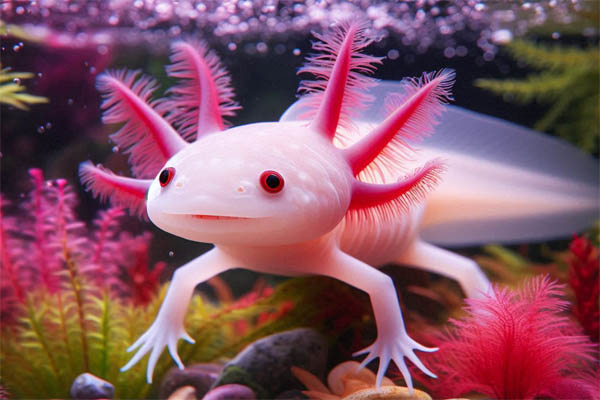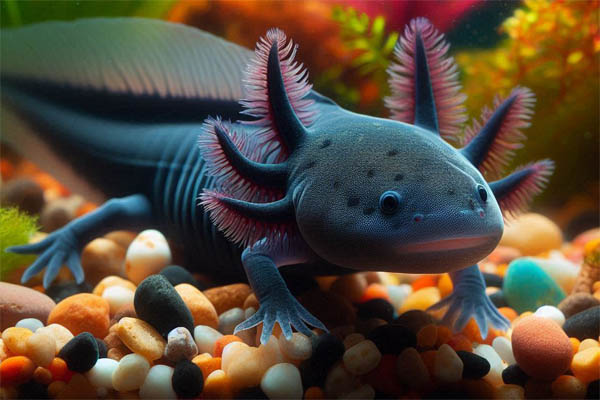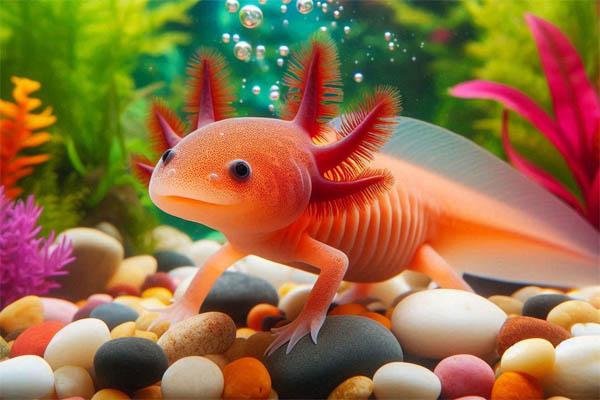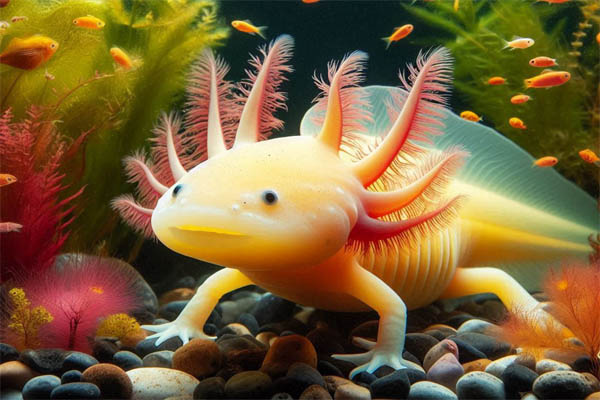Axolotl Colors: Different Axolotl Morphs
Axolotl colors are a fascinating aspect of these unique amphibians, showcasing a wide range of stunning hues and patterns.
Axolotl colors can vary significantly, with some morphs displaying distinctive speckle patterns, while others showcase the vibrant axolotl color that enthusiasts admire.
Among the various axolotl morphs, notable types include white albino, leucistic, and melanoid axolotls.
Each color variant possesses distinct characteristics influenced by pigmentation and the presence of specific cells like melanophores and iridophores.
For instance, albino axolotls are known for their striking red eyes, while golden albino variants exhibit a beautiful golden hue.
In contrast, the melanoid axolotl presents a darker appearance, often featuring a rich black color due to a lack of pigment.
Leucistics, with their pale coloration and black eyes, provide another captivating option for enthusiasts.
Additionally, wild type axolotls display a more natural look, often speckled with shades of brown and gray, and may even exhibit freckles throughout their skin.
The gills of these creatures can also reflect their coloration, contributing to the overall visual appeal.
Furthermore, the introduction of genetic modifications, such as those incorporating green fluorescent protein (GFP), has expanded the palette of axolotl colors, allowing for vibrant fluorescent hues.
With so many options available, the diversity in axolotl colors continues to capture the interest of pet owners and researchers alike.
How Many Colors of Axolotls are There?
There are 5 primary color types of axolotls commonly recognized, commonly referred to as morphs. The most recognized axolotl colors include:
1.) White (Leucistic)

This morph has a pale pink or white body, complemented by dark black eyes. Leucistic axolotls are among the most popular due to their striking appearance, often mistaken for albinos.
2.) Albino

Albino axolotls are characterized by their lack of pigmentation, resulting in a white or golden skin tone and red or pink eyes. This lack of melanin makes them more sensitive to light, and they tend to have a softer appearance.
3.) Black/Grey (Melanoid)

Melanoid axolotls exhibit a dark coloration, typically black or dark grey, and lack the shiny iridescence found in other types. Their matte appearance gives them a distinct look compared to other morphs.
4.) Copper

This morph features a lighter brown hue with a coppery sheen, often with lighter spots. Copper axolotls are rarer than wild-types and leucistic axolotls, making them a sought-after choice for enthusiasts.
5.) Wild Type

While not a distinct color, wild-type axolotls typically exhibit dark brown or black hues with a speckled pattern. This natural coloration helps them blend into their environment in the wild.
In addition to these, selective breeding has produced some rarer colors, like Copper and Chimera, as well as GFP (Green Fluorescent Protein) axolotls that glow under UV light.
However, the primary five are the most commonly available and widely recognized.
Each of these colors reflects different genetic variations, leading to an impressive array of visual diversity among axolotls.
What Is the Rarest Axolotl Color in Real Life?

When it comes to rarity, the golden albino axolotl stands out.
Unlike standard albinos, which have pink or red eyes, golden albinos possess a unique golden hue and pinkish eyes, making them exceptionally striking and rare.
Their genetic makeup contributes to their distinct coloration, setting them apart from more common morphs.
Additionally, axolotls can carry genetic traits that lead to rare color variations or combinations.
For example, certain breeding practices can produce piebald axolotls, characterized by patches of color mixed with white.
However, the golden albino remains the rarest due to its unique combination of genes and limited availability in breeding.
Understanding Axolotl Color: The Role of Genetics, Pigmentation, and Environment
The captivating world of Axolotl color offers a stunning array of hues and patterns, influenced by various genetic factors and biological pigments.
As a unique amphibian species, the axolotl exhibits remarkable color variations, including albinism, leucism, and the wild type, each showcasing distinct phenotypic traits.
The vibrant pink of some axolotls stems from specific proteins and the presence of melanin, while others may display hues like olive and copper, adding to their visual allure.
Chromatophores, specialized skin cells, play a crucial role in determining axolotl color by housing different pigments and influencing their eye color and skin appearance.
This remarkable polymorphism in coloration not only enhances their beauty but also provides insight into animal coloration in general.
Under a blacklight, some axolotls exhibit fluorescence due to green fluorescent protein, further showcasing the intriguing interplay of genetics and environmental factors in their appearance.
Whether admired for their freckles, gills, or the striking hues of their tails, axolotls serve as a fascinating example of how diverse and complex color can be in the animal kingdom.
In exploring axolotl color, it’s essential to consider the intricate biological mechanisms at play, including the role of cells in pigmentation and the impact of various proteins.
The unique pupil structure of axolotls can also influence their perception of color, enhancing their ability to adapt to their environment.
Additionally, the face of an axolotl, adorned with delicate gills, not only serves functional purposes but also contributes to their overall color display.
The concept of bit, though often associated with digital representation, can metaphorically reflect the intricate combinations of genetic information that create the stunning hues we observe in these creatures.
Furthermore, the study of fusion proteins may reveal insights into how specific genetic modifications affect coloration and contribute to the diverse range of axolotl appearances.
These elements deepen our understanding of animal coloration and the biological foundations that allow for such captivating variations in the axolotl.
The axolotl color is a fascinating feature of this unique salamander.
Axolotls can exhibit various hues, including pink and brown, as well as striking piebald patterns with distinct color patches.
Their coloration is determined by specialized skin cells called chromatophores, which contain pigments that interact with light to produce vibrant colors.
Curious minds can turn to Google for more information on the genetics and biology behind these color variations, as researchers continue to explore how different genes influence axolotl coloration.
Overall, the axolotl color showcases the beautiful diversity of this remarkable amphibian.



